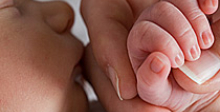Internal mini form
Contact Us Today
Parents are often disheartened to learn that there is no singular test that will accurately diagnose a child with Cerebral Palsy. Once a round of medical evaluations are initiated in order to form a diagnosis, parents prepare for a long and sometimes frustrating process that will, in time, provide answers about a child’s condition.
Diagnosis of Cerebral Palsy
Diagnosing Cerebral Palsy takes time. There is no test that confirms or rules out Cerebral Palsy.
In severe cases, the child may be diagnosed soon after birth, but for the majority, diagnosis can be made in the first two years.
For those with milder symptoms, a diagnosis may not be rendered until the brain is fully developed at three to five years of age. For example, the average age of diagnosis for a child with spastic diplegia, a very common form of Cerebral Palsy, is 18 months.
This can be a difficult time for parents who suspect something might be different about their child. Often, parents are first to notice their child has missed one of the age-appropriate developmental milestones.
If a growth factor is delayed, parents may hope their child is just a slow starter who will “catch up.” While this may be the case, parents should inform the child’s doctor of concerns, nonetheless.
Confirming Cerebral Palsy can involve many steps. The first is monitoring for key indicators such as:
- When does the child reach development milestones and growth chart standards for height and weight?
- How do the child’s reflexes react?
- Does it seem as if the child is able to focus on and hear his or her caregivers?
- Does posture and movement seem abnormal?
Doctors will test reflexes, muscle tone, posture, coordination and other factors, all of which can develop over months or even years. Primary care physicians may want to consult medical specialists, or order tests such as MRIs, cranial ultrasounds, or CT scans to obtain an image of the brain. Even once a diagnosis of Cerebral Palsy is made, parents may wish to seek a second opinion to rule out misdiagnosis.
Why diagnosis is Important?
A diagnosis is important for many reasons:
- To understand the child’s health status
- To begin early intervention and treatment
- To remove doubt and fear of not knowing
- To find and secure benefits to offset the cost of raising a child with Cerebral Palsy
A variety of benefit programs are available to children with disability or impairment. To qualify for these programs, the child must have a formal diagnosis. Without a diagnosis, parents can fall into a limbo pattern.
Who’s on the diagnosis care team?
The process for diagnosing Cerebral Palsy usually begins with observations made by the child’s primary care physician, usually a pediatrician, and the child’s parents. There are some exceptions.
If a baby is born prematurely, or at a low birth weight, he or she is monitored closely in the neonatal intensive care unit of the hospital from time of birth. In extreme cases of child abuse, or shaken baby syndrome a pediatric neurologist called to the hospital’s emergency or NICU unit will diagnosis the child’s condition. In the majority of cases the child will attend regular well-baby visits where the pediatrician first uncovers signs of Cerebral Palsy during examination. In some cases, it is the parents who notice symptoms they relay to the child’s doctor during these visits.
Developmental delay, abnormal growth charts, impaired muscle tone, and abnormal reflexes are early indications of Cerebral Palsy. Because there is no test that definitely confirms or rules out Cerebral Palsy, other conditions must be excluded from the list of possible causes, and Cerebral Palsy must be fully considered. Other disorders and conditions can appear as Cerebral Palsy, and Cerebral Palsy is often accompanied by associated conditions that complicate the process of diagnosis.
What tests do they use?
Since there is no definitive test that can diagnose Cerebral Palsy, doctor’s may utilize one, or a combination, of the following to aid the diagnosis process:
- Assessing reproductive health factors
- Reviewing paternal health records
- Reviewing pregnancy, labor and delivery records
- Reviewing newborn screens conducted at birth
- Considering APGAR score
- Reviewing baby birth, medical, developmental and growth records
- Performing a physical examination of baby
- Performing additional screens (hearing, fatty acids, amino acids and hemoglobinopathies)
- Conducting neuroimaging tests to determine if brain damage exists
- Performing electroencephalography (EEG) or electromyography (EMG) to analyze nervous system function
- Conducting lab tests (blood work, urinalysis or genetic testing)
- Conducting evaluations (mobility, gait, speech, hearing, vision, feeding and digestion, cognitive and rehabilitation needs)
Historically, doctors have been overly cautious when diagnosing Cerebral Palsy and other developmental delays, in part due to the lack of a definitive testing mechanism, and because they felt test results may not be conclusive until the brain is fully developed somewhere between 3 to 5 years of age. Realizing that this was a crucial time for families to bond with their young child, and for the child to develop his or her personality, some conventional wisdom is under the assumption that a formal diagnosis may hamper a child’s development and potential for bonding. Others feared a misdiagnosis and wanted to wait until their diagnosis was conclusive.
For decades the protocol for diagnosing Cerebral Palsy involved observation over months to years, charting developing milestones and noting growth chart vulnerabilities. This can be an extremely trying time for parents who worry about their child’s condition, and have concerns about the need to provide therapy, deploy early intervention and procure adaptive equipment to manage their child’s potential, and minimize the resultant movement and coordination dysfunction. Some parents argue that bonding with their child is a given and that concern should not be cause for undue delay.
And, disappointingly, a small number of parents have expressed their doubts on whether their child’s diagnosis is delayed due to the statute of limitations on litigation should their child’s Cerebral Palsy have occurred due to medical malpractice or negligence. It is not unheard of to learn that some children are well beyond the brain’s developmental stage at the age of 8 or beyond and still without a formal diagnosis.
Concerned that the medical practitioners were being overly cautious to the extent of placing a child’s treatment progress at risk, The American Academy of Pediatrics on May 27, 2013 issued a clinical report titled, “Motor Delays: Early Identification and Evaluation” to help guide physicians through a 12-step process of diagnosis. The hope is that with a formal diagnosis, children were then able to qualify for early intervention, therapies, treatments and governmental assistance.
To learn about the AAP Clinical Report, visit “American Academy of Pediatrics Issues Clinical Report Urging Early Diagnosis of Cerebral Palsy.” To download a copy of the clinical report, visit “Motor Delays: Early Identification and Evaluation.”
The medical examination process can involve multiple doctors, tests, and appointments. During this time doctors will rule out other similar conditions such as:
- Degenerative nervous disorders
- Genetic diseases
- Muscle diseases
- Metabolism disorders
- Nervous system tumors
- Coagulation disorders
- Other injuries or disorders which delay early development, some of which can be “outgrown”
Common tests that involve neurologists or neuroradiologists, include neuroimaging, such as cranial ultrasound, computed tomography scan (CT Scan), and magnetic resonance imaging scans (MRIs). These tests allow neurologists to actually “see” the brain. Various disorders, injuries, and conditions yield different results. These can be used to rule out Cerebral Palsy.
Infants who test positive for a developmental disorder may be referred to medical specialists for further evaluations.
A child may be sent to an orthopedic surgeon to ascertain delay in motor development, record persistence of primitive reflexes, examined for dislocated hips, and assessed for abnormal posture.
Medical specialists are brought in to test hearing, vision, and perception, as well as cognitive, behavioral, and physical development.
A genetic specialist may be consulted for hereditary components.
The pediatrician will document all surveillance, screening, evaluation, and referral activities in the child’s health record.
The lengthy and detailed process can help rule out or confirm Cerebral Palsy. A formal diagnosis is usually made once the brain is fully developed between 2 to 5 years of age.
- Pediatrician
- Developmental Behavioral Pediatrician
- Geneticist
- Neurologist
- Neuroradiologist
- Ophtalmologists
- Orthopedic Surgeon
- Otologists
- Neonatologists
- Pediatric Geneticists
After the child has been diagnosed with Cerebral Palsy, the doctors will ascertain the extent, location and severity of the condition as well as any associative conditions or co-mitigating factors. Cerebral Palsy cannot be cured, however it can be managed. The focus of treatment will be on the management of the child’s health status. This often requires a team of medical specialists. For more information on the management of Cerebral Palsy:
Care Team and Care Plan for Management of Cerebral Palsy
RESOURCES
Diagnosis
For other sources with general information on the cause of Cerebral Palsy, MyChild™ recommends the following:
Centers for Disease Control and Prevention CDC
National Institute of Neurological Disorders and Stroke (NINDS)












